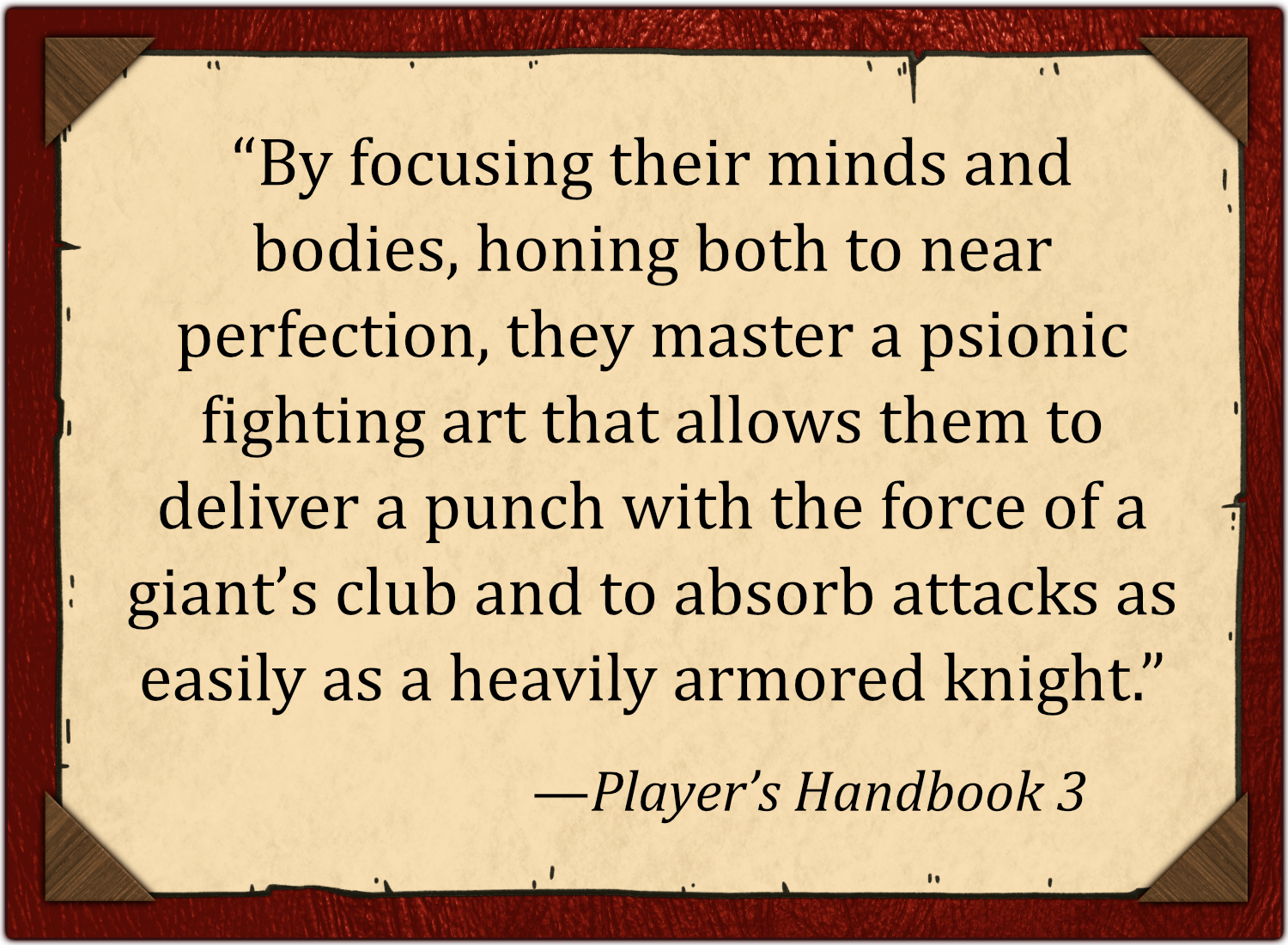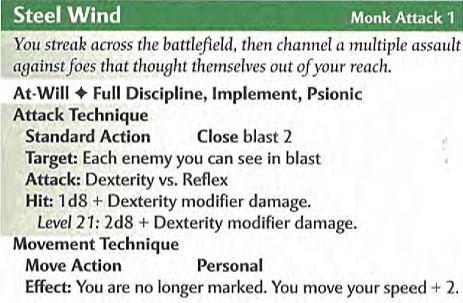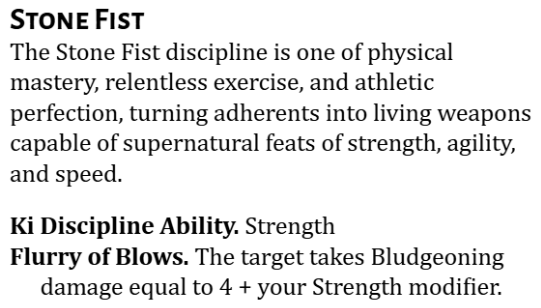Designing 4ever: Stealing from the 4e Monk
Estimated read time: about 18 minutes
So in the last article we introduced our first Primal class for Project 4ever, the Druid. In this blog post we have another new power source to reveal, which we’ll do using our new Monk class! Read on to see what we’ve settled on for this master of martial arts.
Oh, we tend to use some language borrowed from Dungeons & Dragons 4th Edition in these articles, so if you need to brush up on what power sources or combat roles are, feel free to give those articles a quick read.
As we usually do, we’re going to start off this discussion going over the cool things the Monk offered in Dungeons & Dragons 4th Edition. If you’re already familiar with the 4e Monk or would just like to cut to the chase, feel free to jump to the “So What Are We Stealing?” section.
4e’s Psionic Power Source
In the Player’s Handbook 3 we got 4e’s take on the psionic classes, which included the Monk as the power source’s Striker. This was a new take on the Monk, reinterpreting its “Ki energy” as a form of psionic discipline. It was a bit puzzling to me at first for the Monk to be in the same category as the Ardent, Battlemind, and Psion classes, but the book’s text actually sold me on it to some extent. I bought the narrative. For me, the problem was the 4e Monk’s mechanics. Which is strange, because the 4e Monk is my favorite version of the class.
Let’s unpack this a bit.
See, the other three Psionic classes shared a new mechanic: power points. These power points were a sort of currency exclusive to the Psionic classes, and could be used in conjunction with their at-will powers to beef up their attacks in cool ways. In a system that until this point had mostly homogenized class structure (at-will powers, encounter powers, and daily powers), these power points let the Psionic classes stand out as something different from the other classes.
But… the Monk was the only “Psionic” class that didn’t get power points. Its features didn’t function exactly like 4e’s original class structure, but it bore more resemblance to that than to the other “real” Psionic classes. So in spite of the well-written narrative surrounding the Monk enhancing its martial discipline with psionic energy, it simply didn’t fit with the other Psionic classes mechanically. And that was weird.
That oddity aside, the 4e Monk had a lot of things going for it. Like the idea of “full disciplines”!
Full Disciplines
Having the Striker role, the Monk needed to be able to hit hard—and it did. But another tendency of Strikers (particularly melee ones like the Monk) was that they needed to be able to get to their chosen target in order to take it down, and so they often got features that helped them to be fairly mobile on the battlefield. In my opinion, the Monk was the best at finding ways to get where it needed to be. It had a specific focus on mobility literally built right into its at-will and encounter powers.
Here’s one to look at:
Between the “Attack Technique” and the “Movement Technique”, each power was literally two powers put together, giving the Monk options galore for simply moving across the battlemap. Speed increases, shifts, jumps, wall-runs, and even temporary flight were commonly included alongside high-damage attacks that usually involved sliding enemies around or disabling them somehow. As far as mystical martial artists go, I don’t think any edition let you live that dream as well as the 4e Monk did.
In other words, there’s a lot of great stuff to steal for Project 4ever!
So, What Are We Stealing?
Mostly I want to capture the ease with which 4e enabled the Monk to accomplish its combat role. So we’re keeping it a Striker, which will help us infer some of its other stats, such as Hit Points and AC.
As for its Power Source, you’ll have to see what we’ve come up with!
Level 1: Hit Points & Proficiencies
I’ve seen in some game systems that the Monk class should have Hit Points on par with the Fighter. In 4ever, however, the Fighter is a Defender—literally a “tank” class—so I don’t think we should set that same expectation here. Sometimes we “boost” a class’s Hit Die a little bit if it’s a Martial or Primal class, but the Monk is neither. A d8 should be sufficient; it can usually handle itself in melee combat to a degree, but probably shouldn’t go toe-to-toe with the enemy’s heavy-hitters for too long without some support.
For armor training, we’re sticking with the Monk’s narrative tendency to go unarmored, which in 4ever means wearing Cloth Armor. In fact, most of the Monk’s other features will “turn off” if it wears anything other than Cloth.
Level 1: Martial Arts
This feature basically functions as support for the Monk as an unarmored, unarmed combatant. It gives two benefits: a +2 bonus to AC (so long as you’re not wearing armor other than Cloth and while not using a Shield), and you can use your Dexterity modifier for your attacks with unarmed strikes and Monk weapons. You deal 1d8 Bludgeoning with your unarmed strikes.
For a while we had that d8 damage die apply for any Monk weapon we used, but that just led to always using a Dagger for its Accurate property. This change should make that less of a must-do.
Level 1: Monastic Training
While 4e leaned heavily into the narrative of a Monk’s abilities being mystical and supernatural, 5e 2024 has largely backed off of that idea. And well, there are some good reasons for that, what with the problems Monks have had in kind of (poorly) representing some real-world cultures. For me, the actual words written in the 4e books about D&D “Monks” did a good job of setting them up as warriors who tapped into an inner reservoir of energy—and this has to do with the power source we’ve set up for them in 4ever. We didn’t want them to be a Psionic class, and we didn’t want them to be a strictly Martial class either. So we took inspiration from this sidebar in the first 4e Player’s Handbook:
This sidebar explicitly sets up Monks as drawing from a different power source than Psionic, and gives two names for it: “soul energy (or ki)”. We’ve decided to interpret our Monk class as having the “Soul” power source, that inner reservoir of energy, and the way that they accomplish that is through their technique called “ki”. Other classes powered by Soul (and we’ve been drawing up ideas for them) will have different ways of accessing that same source of energy. Monks just call theirs ki.
Anyway, that was a long way to explain that with this Monastic Training feature, each Monk gets to choose the ability it uses to access their Soul energy—and there are a bunch of options. Here are some of the more typical ones:
As you can see, each one also grants a unique “Flurry of Blows” feature. This is where a lot of the Monk’s Striker damage comes from. Basically after hitting a creature on your turn, you can use a Bonus Action to activate your Flurry of Blows, which deals some extra damage to a creature of your choice and sometimes also a secondary effect. From the two options shown here, Stone Fist is all about dishing out that extra damage, while Centered Breath lets you also fill some of the Controller role.
Level 1: Movement Techniques
This is where the Monk really shines, and it’s also trying out a new mechanic that might be shared with a few other classes. See, the Martial classes, as well as the Barbarian and the Monk, get “maneuvers” at level 2 that they learn and use. We’ve decided to introduce a class-based currency for executing these maneuvers, called “Focus Points”. Maneuvers that involve making attack rolls cost 2 Focus Points and usually use your action, while others cost only 1 Focus Point and usually use your Bonus Action.
That’s all well and good for those classes, but the reason I bring it up is that unlike those other classes, the Monk gets its Focus Points at level 1, specifically for the use of movement techniques. As the name might indicate, these are special Moves that a Monk can take to weave its way around, through, and over the battlefield.
Here are a few examples:
So you get to pick just two movement techniques from a list of about ten, you’ll learn some more as you level up. Each one costs just 1 Focus Point to use, and the Focus Points come back on a Short Rest, so you’ll be able to use these fairly often to get to wherever you want to be on the battlemap.
Level 2: Monastic Maneuvers
As promised, here is the Monk’s version of maneuvers. There’s a pretty good list to choose from, and like other classes that learn maneuvers you get to pick four to start.
Let’s look at a couple of them:
This maneuver reinforces that classic Striker gameplay—pick a target and hit it hard. Provided you pick a target that hasn’t taken any damage yet, you get that additional weapon damage die added in. And remember that hitting an enemy lets you use your Flurry of Blows, so there are a lot of synergies that a creative player can figure out.
This maneuver basically lets you attack each enemy adjacent to you, and knock them Prone on a hit! As far as Strikers go, the Monk is almost as good at attacking multiple targets as a proper Controller. And combined with the movement techniques from level 1, it’s easy to see how you can place yourself exactly where you want to be to dish out the most hurt possible. Just make sure that you don’t draw too much aggro from the baddies; your defenses tend to be decent, but not unbeatable.
Level 3: Monk Subclass
As far as subclasses go for this first playtest iteration of the Monk, we’ve got three good ones:
Way of the Ghostwalker: Slip between the mortal realm and the Shadowfell as you conceal yourself with soul magic, teleport around the battlefield, and weaken foes by striking directly at their spirits.
Way of Hellfire: Learn a mix of brutal martial arts inspired by the combatants of the Blood War. Will you be drawn towards one side of the conflict or the other, or strike a balance between them like the River Styx itself?
Way of Transcendence: This is your more stereotypical Monk, focusing on perfection of the self to become something greater than the sum of your parts. Your enemies don’t have a prayer of locking you down or escaping your pursuit.
Level 4: Soul Inspiration
Being the first Soul class to see play in Project 4ever, we’re excited to see what people think of the power source. Here’s a feature that all Soul classes will share, a deceptively small boon that can turn the tide of a difficult battle.
Here it is:
It’s a decent ability, but we’re trying hard to nail down the feeling of this new power source. Let us know your thoughts on it and if it lines up with your expectations, or if you feel it can use a different take.
Level 5: Weapon Prowess
By this point we should feel pretty familiar with this feature and how it comes into play for classes that rely on making physical attacks, but here it is for the Monk:
It’s important to note that unarmed strikes are “weapon” attacks, as opposed to “spell” attacks or some other kind of attack.
Level 5: Mastery Techniques
A martial-adjacent class like the Monk wouldn’t feel complete without unlocking some sort of big attack at level 5, and so we’ve given the Monk “mastery techniques”. These don’t require Focus Points, but you can only do them once per Long Rest. You start with just one of your choice, but you unlock more as you level up.
Here’s an example of a classic high-powered Monk attack:
Sure, the 5e Monk can attempt to stun enemies more often, but this mastery technique deals heavy damage and the stun effect can potentially last for much longer. Pity the enemy hit by this one!
Wrapping it Up
And that is the Monk! We’re getting close to releasing the actual document with these additional playtest options, which will also include the Paladin and the Warlord. Keep an eye out for articles digging into those new classes as well!
We can always use more playtesters and feedback! If any comments or questions occurred to you in reading about the Monk, we’d love to hear what you’re thinking. You can use the comment section below, or chat with us directly via our growing Discord server! Don’t hesitate to reach out, we’re happy to hear from you.
Until all of that, happy gaming, and we’ll see you in the Archives!
















